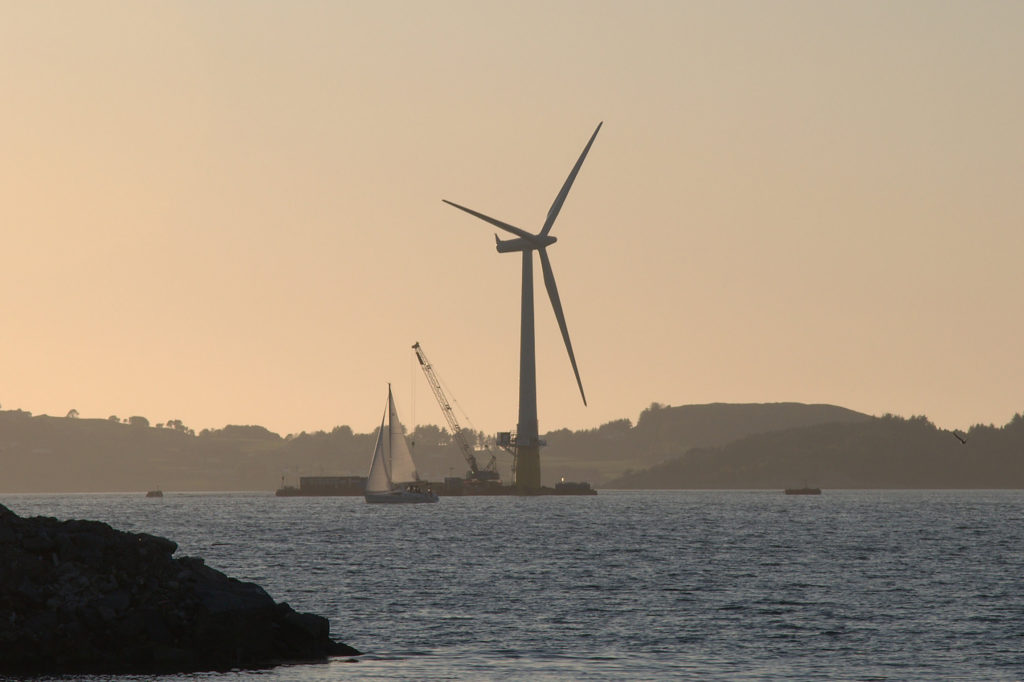Windfarms at sea are the kind of project where we think Zero West can make a real impact. They are already an important part of government policy – with a commitment to 30GW of generating capacity by 2030 published just this month (March 2019).
We are convinced we can do even better. And organising regionally – or a bit wider – will help mobilise support, and finance, for a project that is big enough to benefit from the latest technical developments. The near-term possibilities need a lot of planning and co-ordination, and lead times could be long. But at the end of the road lies a big win: a large energy supply that is carbon-free in operation, and reinforces the UK’s place in an industry that is likely to be globally significant.
A bit of history.
When Zero West began scoping projects, a first thought was to revisit the case for a (then) massive wind project known as the Atlantic Array. Despite the name, this was actually a plan drawn up in 2007 for 240 turbines that were going to sit in the Bristol Channel, delivering 1.2 gigawatts to North Devon and South Wales. It got quite a long way through the planning process, but was canned by the developers (Farm Energy, now part of RWE) late in 2013, for financial and technical reasons.
In November 2017 a group of people with knowledge of the Atlantic Array met to discuss whether there was interest in resurrecting the scheme in some form. As it happened, this coincided with the Crown Estates – who own the UK seabed – announcement that it was considering offering new seabed rights to offshore wind developers.
It looked as if the current technical, economic and political climate for offshore wind was more favourable than in 2013. However, given the high cost of the onshore facility needed to build and maintain a wind project, it would make more sense to build a cluster of projects across a much wider area stretching to Wales and potentially Ireland.
Exploratory work ensued with the Crown Estates and other interested parties. The technology is well-established. But that also means there are other parts of the country well-placed to bid for new sites in the complex process that involves licensing by the Crown Estates, tendering and “contracts for difference” (CfDs), in which the government guarantees a price for electricity supplied over the production life of a wind farm. As a result, the Crown Estates didn’t assign any plots to the South West because their priority is to do as much as possible with the existing technology and facilities in the next five years.
But that isn’t the end of the story. It meant that our regional conversation took a different direction: floating wind farms.
Floating – far out.

Wind farms worldwide have so far been turbines on a base planted in the seabed. The UK has been a leader in this technology, exploiting our combination of windy coastlines, aerospace expertise, and offshore oil and gas companies who know how to build things out at sea.
However, at some point we run out of coastline. In theory that’s a limitation that can be overcome by making wind turbines that float. They can also be placed further out to sea – where winds tend to be stronger. Making and fixing them ought to be cheaper because they could be built in harbour, towed into position by regular tugs, and brought back to a maintenance yard if they need an overhaul. That’s also likely to encourage people to make turbines bigger.
And it’s no longer a theory. The world’s first floating wind farm is now up an running 25 km off the coast of Aberdeenshire in water 120 metres deep. It uses units developed by the Norwegian firm Statoil which are tethered to the seabed by three cables, and have special tech to minimise the effects of pitching in the waves on the wind turbine’s output. So far, it has been a superb demonstration project, with the five 6MW turbines recording an average of 65 per cent of their possible output between November 2018 and January 2019. That compares well with fixed wind farms, that typically manage 45-60 per cent output.
In our neck of the woods, realistic future plans for renewable electricity delivery, which will include supplying power for charging electric vehicles and for much more home heating, will include looking beyond our region. The excellent, detailed West of England Energy Study produced by the Centre for Sustainable Energy in 2018 concluded that:
“Achieving significant decarbonisation of the electricity used by the region will rely not only on capturing a decent proportion of the available within-region resource but also on the development of renewable energy in other parts of the UK, particularly offshore wind and in Scotland.”
Bringing the FLOW
So what are the prospects for bringing Floating Offshore Wind (FLOW) to the South West of England? The technology is very promising, but hasn’t yet benefited from the cost reductions that have boosted regular offshore wind farms. And the advantages of floating turbines come with some additional complexity in their operation, and a need for longer cables to bring the power where it’s needed.
Some months ago Cornish MPs facilitated a meeting with government minister Claire Perry where she heard a proposal for a three step development from Steve Jermy of the Isles of Scilly Local Enterprise Partnership. This would build out from the existing wave energy hub in Cornwall, which already has a grid connection.
The minister then asked the team to submit a ministerial proposal. This was submitted and accepted, and the team has now been asked to submit a more detailed one.
These discussions were under the radar for a while, but the goal now is to secure backing for this development as both a contribution to innovation in energy supply and a regional economic development initiative that would help ensure future floating wind farms are built with UK engineering input. Zero West’s wind group will work with others to get all seven local enterprise partnerships in the South West supporting it.

